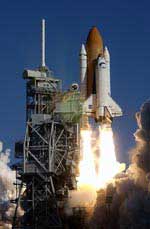UMR partners with NASA to develop new techniques for inspecting space shuttle foam
Posted by news
A University of Missouri-Rolla graduate student will spend his summer and most of next year assisting scientists at the NASA Marshall Space Flight Center in Alabama in developing methods to perform microwave nondestructive evaluation (NDE) on the space shuttle’s external tank insulating foam and other NASA applications. A large piece of insulating foam broke off during Columbia’s liftoff last year and struck the orbiter’s left wing, leading to the loss of Columbia and its crew.
 |
| Space shuttle Columbia |
Under the direction of Dr. Reza Zoughi, the Schlumberger Professor of electrical and computer engineering at UMR and director of UMR’s Applied Microwave Nondestructive Testing Laboratory, Joseph "Toby" Case of Rolla, Mo., a graduate student in electrical and computer engineering at UMR, will help NASA investigators set up their own microwave NDE laboratory. UMR’s Applied Microwave Nondestructive Testing Laboratory is one of the few facilities in the nation to conduct microwave NDE, Zoughi says.
"NASA has seen the potential for this kind of technology," Zoughi explains. "This is not just a grant but more of a collaboration. It’s good that an organization like NASA has decided to go beyond grants and actually get involved in it themselves because that gives us more credence in what it can potentially accomplish. I think we all will win."
In the days following the Columbia disaster, NASA asked Zoughi to evaluate samples of foam using near-field microwave NDE. It was the first time NASA had considered using this particular method to detect air bubbles (called "voids") and debonds, which are separations between layers of foam or between a layer of foam and the fuel-tank base.
"We were able to show that you can use simple microwave techniques to look for a good number of different types of flaws that may exist, like voids," Zoughi says. "Most of these were manufactured flaws, things they embedded in a sample. The key is to be able to detect naturally occurring flaws, and I believe we can significantly enhance NASA’s ability in finding these kinds of nonconformances."
Based on the technique’s demonstrated success, NASA has asked Zoughi and Case to determine the feasibility of using microwave NDE to create higher resolution images than previously possible.
"We need to go to the next step and make sure that, in the presence of more complex features and structures, we can still find these potential indications," Zoughi says. "We have proposed several different ways that this may be possible. We are going to actually study their properties and find out which one would be appropriate or not. Then we’ll take some that are more promising methods and actually put them in the lab and try to emulate them."
The research is supported by a two-year, $265,000 grant from the NASA Marshall Space Flight Center.